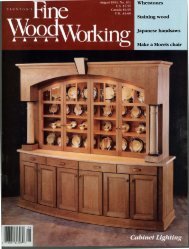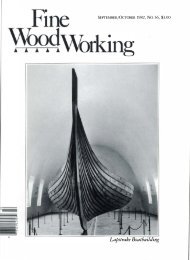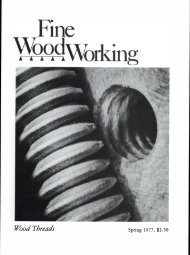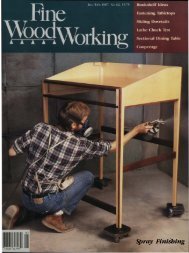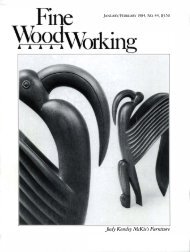NOVEMBER/DECEMBER 1983, No. 43, $3.50 Making ... - Wood Tools
NOVEMBER/DECEMBER 1983, No. 43, $3.50 Making ... - Wood Tools
NOVEMBER/DECEMBER 1983, No. 43, $3.50 Making ... - Wood Tools
You also want an ePaper? Increase the reach of your titles
YUMPU automatically turns print PDFs into web optimized ePapers that Google loves.
duction motor, the Emco has plenty of power and never<br />
stalled, even when pushed hard. At the slow feed rate, thicknessing<br />
100 bd. ft. of 4/4 lumber will likely take the better<br />
part of a day, and boards wider than the lO:Xs-in. maximum<br />
will have to be ripped down.<br />
The Emco jointer guard consists of a sheet-metal stamping<br />
held above the cutterhead by an adjustable arm. For edgejointing,<br />
it slides away from the fence; for face-jointing, you<br />
shove the board under the guard, an operation requiring you<br />
to lift your hands (or, better yet, push blocks) as you pass the<br />
guard. This little shuffle leaves an unjointed bump in the<br />
board, which the planer must skim off. I ignored the temptation<br />
to work without the guard: 10 in. of exposed cutterhead<br />
is too scary.<br />
Because its tables are supported on both edges, the Emco<br />
jointer is more accurate than the Belsaw, but still toO short for<br />
truing long stock. Anyone accustomed to an expensive jointer<br />
will find the movable, tiltable fence flimsy, yet it's solid<br />
enough, and would be quite good if you bolted a wide board<br />
to the fence to lengthen and stiffen it.<br />
The Inca 3<strong>43</strong>-190 jointer tables, bed and frame are made of<br />
pressure-cast aluminum, generously ribbed for strength and<br />
bending resistance, resulting in a tool that's very rigid, yet, at<br />
114 lb., the lightest of the group. The tool I tested, which<br />
should be available this fall, is an improved version of the<br />
discontinued model 510. Its jointer tables are a usable<br />
42Yz in. long, and it will plane and joint boards lOX in. wide.<br />
The Inca has an unusual feature for a planer in this price<br />
range: a two-speed feed 0l.5 ft/min., 16.5 ft/min., and<br />
Inca 's combination is the only one of five tested that sports two<br />
feed rates, which are controlled by the lever above the motor. The<br />
flap screwed to the jointer fence covers the cutterhead when the .<br />
fe nce is moved forward.<br />
44<br />
neutral) which can be changed by a shift lever while the wood<br />
is being planed. When I wanted to shift speeds, however, I<br />
always found myself standing on the side of the machine opposite<br />
the lever. Anyway, even at its high speed, the Inca is a<br />
slowpoke. I would have been glad to trade the speed changer<br />
for a decent depth feeler gauge, which the Inca lacks.<br />
The Inca does a beautiful job of planing, especially if you<br />
take thin cuts, which you can do because the knurled feed<br />
rollers don't mar the wood the way the Emco's do. On the<br />
goncalo alves, the Inca tore out less than did the other<br />
planers, perhaps because its cutterhead knives are supported<br />
right out to their tips, thus limiting chatter. The Inca was<br />
outstanding at planing very thin pieces of wood (less than<br />
Ys in.). The standard 1Yz-HP motor is too small, however, and<br />
prone to stall. Garrett Wade, the Inca distributor, says a<br />
2-HP (220V) motor is a no-cost option. I'd recommend it.<br />
The Inca converts from planer to jointer similarly to the<br />
Emco. Also, like the Emco's, the Inca's jointer guard gets in<br />
the way. When face-jointing, wide boards chatter unless you<br />
press downward fairly near the cutterhead. I found this awkward<br />
to do. The jointer fence is one piece of solid, heavy<br />
aluminum supported on a ribbed pedestal a third of the way<br />
down the infeed table. This arrangement isn't rigid enough,<br />
and though it's stiffest where you apply pressure when edgejointing,<br />
it deflects more than I like at the outfeed end. I was<br />
able to rig my shop vacuum to collect the planer's shavings,<br />
but couldn't do the same for the jointer-it dumps them on<br />
the planer table. A new plastic hood developed by Inca supposedly<br />
solves this problem.<br />
Of all the machines tested, the Inca's knife-adjustment system<br />
is the most accurate. Each knife has two slots into which<br />
the head of an Allen bolt fits. Turning these bolts raises or<br />
lowers the knife. This system is handy if you have knives that<br />
are low at the center, as mine were. I raised both ends about<br />
0.005 in. until the center was at the correct height, snugged<br />
the center locking bolts, then lowered each end to the correct<br />
height. To measure knife height, Inca supplies a very nice<br />
$80 dial indicator with an aluminum base, although I got<br />
just as close using the Emco method and a flat, straight piece<br />
of wood.<br />
The Makita 2030 is one of a half-dozen stationary woodworking<br />
tools sold by Makita in the United States. Solidly<br />
constructed, it shows how the Japanese are using cast iron<br />
much the way Inca uses aluminum: relatively thin castings<br />
with plenty of stiffening ribs. You can also buy the machine<br />
with a 14-in. non-tilting circular ripsaw mounted alongside<br />
the planer (model LM3001). If you already own a radial-arm<br />
saw instead of a tablesaw, such a combination might be ideal.<br />
The Makita will plane boards up to 12 in. wide and joint to<br />
6Ys in. wide.<br />
The Makita arrives ready to run (ditto the Hitachi), but<br />
the two columns upon which the machine is supported elevate<br />
it only 20 in. above the floor-uncomfortably low for my<br />
6-ft. frame. I bolted the machine to a 2x4 stand on locking<br />
castors, raising the jointer table to about 35 in. above the<br />
floor. I included castors on the stand so that I could roll the<br />
276-lb. machine around in my cramped shop.<br />
Most Japanese stationary machines, including the Makita<br />
and Hitachi combinations, are powered by universal motors,<br />
not induction motors. Universal motors, which also drive<br />
routers, are small and light, but must whine up to high<br />
(continued on p. 46)



